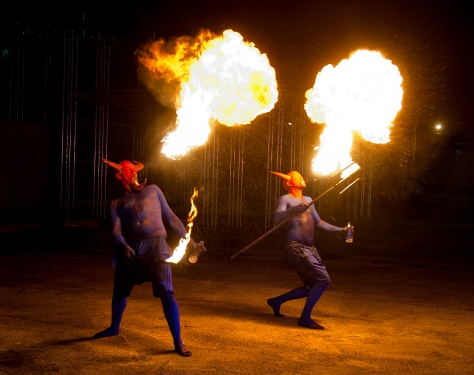by JT Talley
Note: This is the fourth in a series of blogs from students who participated in the BCC’s Fall 2014 Research Tour to Trinidad & Tobago on Oct. 10-15.
Limin’: Trinidadian slang synonymous with resting, relaxing, hanging out, or just chillin’. It falls in line with a culture of knowing and enjoying what you are, who you are, and where you are in the moment. And we definitely enjoyed ourselves in Trinidad and Tobago. During the Purdue Black Cultural Center’s research tour to these Caribbean islands, we were tasked with unmasking blackness in a culture of celebration. And Trinidad is widely known to be the founding country of the largest celebration on Earth: Carnival.
We got a taste of this celebration on the very first day. The same night we arrived in Trinidad, the Carnival Institute of Trinidad and Tobago gave us quite a show. They had us parade with them around Queen Savannah Park and introduced us to some traditional characters of Carnival. There was loud music, fire blowers, whips cracking, weird costumes, and beautiful women. The whole experience was confusing, scary (I’ll mention why in a moment), and EXCITING! It was exciting because you could feel the spirit of celebration in the atmosphere. It was scary and confusing, though, because everything was so new and different.
It was hard to see and understand the point of some of the characters at first. There were devils, people in skeleton costumes with a collection of skulls, masked giants on stilts, and women holding babies looking for the father in the crowd. Especially being a man of Christian faith, I was not sure how to interpret the presence of devils and men with skulls. After letting myself be open to the experience, however, it all became clear.
These characters were not just for some random method of celebration, but rather played a double role in life lessons for the future generations. All the characters and all the costumes had a purpose of showing and teaching on having pride in one’s heritage and warning them about things such as drug usage, alcoholism, and teenage pregnancy. Everything seemed to have a purpose, down to the tiniest detail. And the artists embraced this purpose to the fullest extent, tying everything they did back to the character they portrayed.
I mean, it really only makes sense when you think about it. Carnival itself has a great underlying purpose that many outsiders don’t seem to recognize. The people who started Carnival weren’t celebrating for no reason. It wasn’t some period of overindulgence before Lent, like in the European version made in an attempt to copy the originators. It’s a celebration of resilience of a people to overcome adversity. It’s a celebration of survival and freedom from the injustices of the olden slave days. And you can see this very clearly in their pride, in their performance, and in their speech. Because if you try to ask them who they are, someone will answer, “You know who I am. My name’s survivor.”





